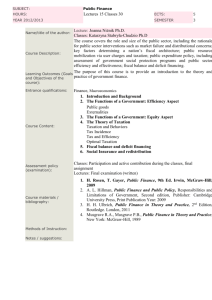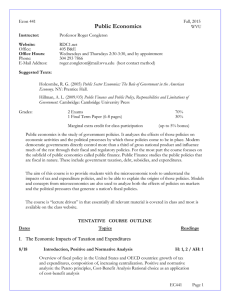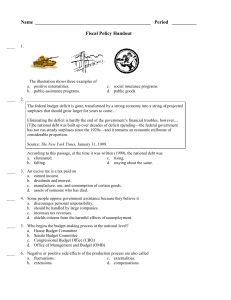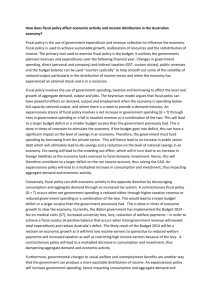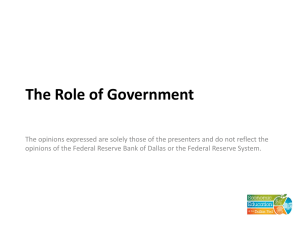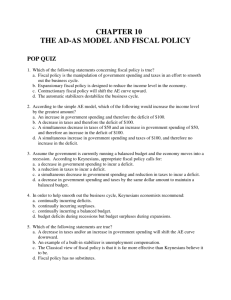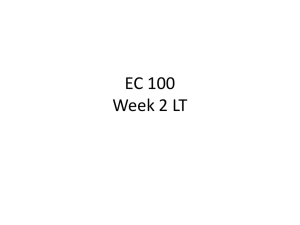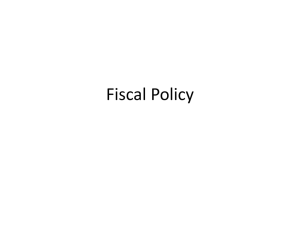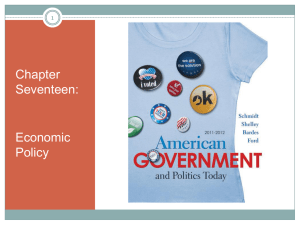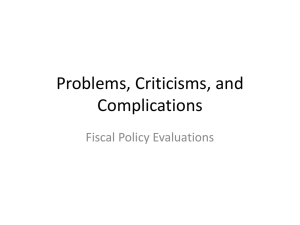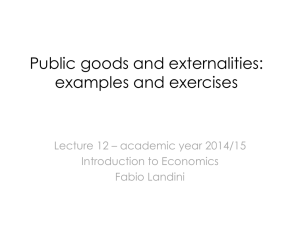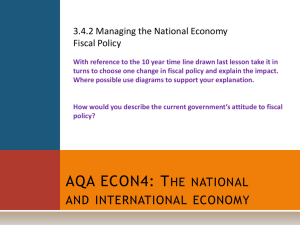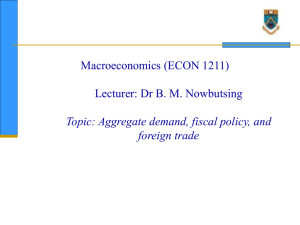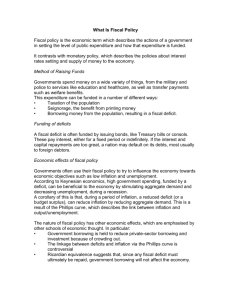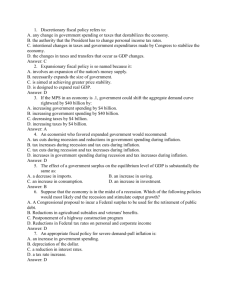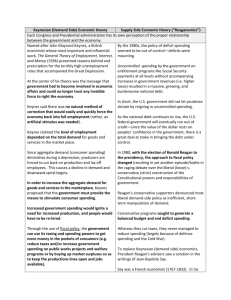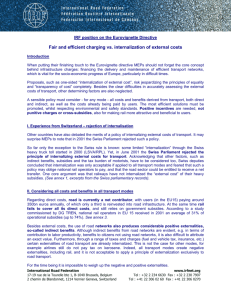Handout 1 - CA Sri Lanka
advertisement
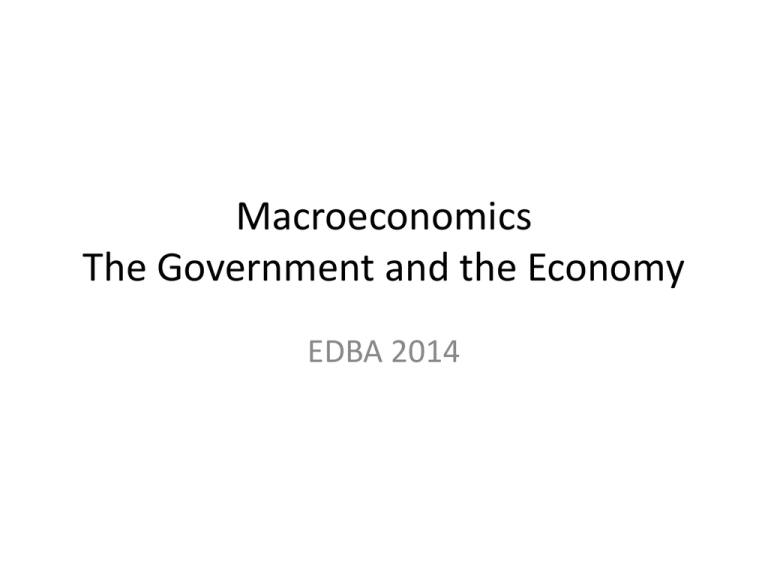
Macroeconomics The Government and the Economy EDBA 2014 Solving World Problems! • • • • Governments and the Economy Circular Flow and National Public Accounting Money and Price Level International Trade Market Failure • Market Failure – “A condition that arises when unrestrained operations in the markets yield socially undesirable outcomes” • What do governments do to prevent market failure? – Establishing and Enforcing the Rules of the game • Market efficiency depends on people using your resources to maximize your utility. – Promoting Competition • Preventing firms from colluding. – Regulating Natural Monopolies • Natural monopolies – when one first serves the market at a lower cost than other firms. (and charges a higher price than socially optimal) – Providing Public Goods What is a Public Good • A public good is a good that is non-rival and non excludable. – Non-Rival – Means consumption of the good by one person does not reduce the availability of the good for others. – Non Excludable – means that no one can effectively be excluded from using the product – Examples: Air, Mp3 Songs, Youtube Excludable Non-Excludable Rivalries Private goods – Food, Clothing Cars Common Goods – Fish Stocks, timber Non-Rivalries Club Goods – Cinema, Private parks, satellite television Public goods – National TV, Defense • Taxes are used to pay for public goods! Externalities – Dealing with Externalities • Externality – a cost or benefit that falls on a third party and therefore ignored by the two parties to the market transaction. – Negative externalities - pollution – Positive externalities – beautification of the neighborhood • Market prices do not reflect externalities • Governments use the items below to discourage negative externalities and promote positive positions – Taxes – Subsidies – Regulations What do governments do to prevent market failure? • A more equal distribution of wealth – Resource markets does not guarantee a minimum level of income. – TRANSFER PAYMENTS – Reflect societies attempts to provide a basic standard of living. – This is also called welfare economics • • • • • Minimum Wages Price Floors Price Ceilings (Rent Control) Taxes Subsidies Minimum Wage • This is relatively prevalent in Western Countries Price Floors • A price floor is a government or group imposed limit on how low a price can be charged for a product • Effective Price floors are when the price floor is greater than the equilibrium price. Price Ceiling • • A imposed limit of the price charged for a product Only if the price ceiling is below the equilibrium price will it be effective. • Consequences of Price Ceilings – Black Markets – Reduction in Quality – Discrimination Taxes • You can tax the firm or the consumer. • Taxes change behaviour. Subsidies • Is a form of financial assistance paid to a business sector. • Subsidies are given to – Prevent the decline of industry – Keep the cost of living down Most important role of the government • The most important role is to foster a healthy economy. • Full Employment, Price Stability and Economic Growth. • To do this governments use – Fiscal Policy – pursuing a healthy economy by using taxation and spending is known as fiscal policy – Monetary Policy – Regulating the money supply to achieve a healthy economy is called monetary policy. Imperfect Information • In competitive theory we assume all players enjoy perfect information. • Imperfect information can cause the misallocation of resources and possibly market failure. • Imperfect information can be caused by – – – – – Misunderstanding the true costs or benefits of a product Uncertainty about costs and benefits Complexity of information Inaccurate or misleading information Addiction. Fiscal Policy and its Instruments • Fiscal Policy – The use of government purchase and transfer payments, taxes and borrowing to influence aggregate economic activity such as inflation, employment and economic growth. – The two main instruments of fiscal policy are • Taxes • Government Spending Taxation in Sri-Lanka • According to the Inland Revenue – Income Tax – VAT – introduced in 2002 to replace GST • Standard Rate 12% • Luxury 20% – – – – – – – Economic Service Charge (does not exceed 30 million) Debits tax – 0.1% of all savings and debit accounts Betting and gambling levy Nation building tax – 3% if your turnover is over 6500000 Stamp Duty Social Responsibility Levy Turnover Tax Taxation in Sri-Lanka • Currently the tax revenue is 14% of GDP • Used to be 19% in 1992 • Taxes – Proportional – a fixed tax rate – Progressive – a tax by which the tax rate increases as the taxable base rate increases – Regressive – a tax where the rate decreases as the amount subject to taxation increases. Budget Deficits • A deficit is the amount by which a sum of money falls short of the required amount. • When you have a deficit what can you do – – – – You can borrow You can ask for a raise Sell some assets Spend less • Governments do the same as shown above except one extra thing – They can print money Budget Deficits Continued • Gt – Tt (primary deficit) • G – Government Spending • t – Time Frame • T – All forms of taxes. • Total Deficit = Spending + Interest Payment on Debt – Tax Revenue • Budget Deficit Country Comparison https://www.cia.gov/library/publications/the-worldfactbook/rankorder/2222rank.html • The principal is that we are “investing” • We borrow We invest We reap higher tax revenue later • It eventually has to be paid back. Multiplier Effect • When the government spends 1 billion rupees worth of construction from a local company there are consequences. – – – – Higher demand from the government Increasing Employment Higher wages, higher profits Increased spending • Because each rupee spent by the government raises aggregate demand by more than a rupee, government purchases are said to have a MULTIPLIER EFFECT on aggregate demand. Crowding Out Effect • There is another effect working in the opposite direction. • As income rises, people choose to hold on to their money in liquid form. – – – – There is an increase in demand for money Government increases interest rates This reduces investment spending This puts downward pressure on aggregate demand. • The reduction in aggregate demand that results when a fiscal expansion raises the interest rate is called the CROWDING OUT effect. Privatization • Privatization is the process of transferring owner of a business, enterprise, agency or public service from the public sector to the private sector • Pros – – – – – – – • Performance Increased Efficiency Specialization Less Political interference Less corruption Accountability Profit motivation Cons – – – – – Profit may not be the motive Capital Strategic and sensitive areas (defense) Essential services Job loss

